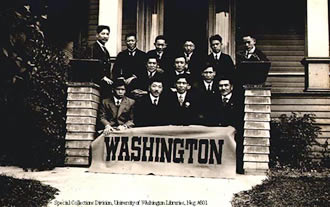
Lesson Twenty-two:
Asian Americans and the Modern Pacific Northwest
I have argued (in Lesson 20) that World War II served as a critical turning point for the 20th-century Pacific Northwest. The experiences of people of East Asian descent in the region certainly bear out the claim. The war and its aftermath were pivotal in their lives, particularly regarding their status as immigrants to and citizens of the United States. The clearest impact, of course, was the wartime internment of Japanese and Japanese Americans, by which more than one hundred thousand people—most of whom were American citizens—were imprisoned on the basis of race (as well as geography, since only those people of Japanese descent on the west coast were incarcerated). But other crucial changes occurred as well. The war initiated reforms to U.S. immigration and naturalization policies, and the Cold War and civil-rights movement that followed accelerated the transformations. The attitudes of white Americans toward peoples of Asian descent also changed substantially, so that by the 1960s and 1970s some Asian Americans came to be viewed as a "model minority." Moreover, the numbers and varieties of Asians coming to and residing in the United States changed with and after the war. America's military involvement in Korea and southeast Asia resulted in more peoples from those areas joining the peoples of Chinese, Japanese, and Filipino descent who had already established substantial communities in the United States.(A History Bursting With Telling: Asian Americans in Washington State)
Clearly, to appreciate the experiences of people of Asian descent in the Pacific Northwest, we need to look closely at laws, policies, and relationships that were national and international in scope, rather than regional or local. The states of the Pacific Northwest did not create immigration regulations or determine foreign policy. Federal officials did respond to the lobbying and opinions of white Westerners—including people from Oregon, Washington, and Idaho—when deciding what to do about the Chinese in 1882 or how to handle the Issei and Nisei in 1942. But immigration and naturalization policies were creatures of the U.S. Congress, Supreme Court, and Presidency. They represented still another powerful federal influence on regional life. By and large, U.S. immigration and naturalization policies have been remarkably liberal or tolerant, compared to those of other nations around the world. But those policies did not always live up to American egalitarian ideals because they were racist, toward Asians in particular.
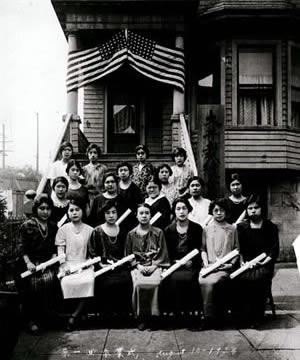
To understand the importance of World War Two, the Cold War, and the civil rights movement to peoples of Asian descent, one must appreciate how the law treated them before 1940. As pointed out in Lesson 15, Asians became the first population of foreigners to be restricted from free immigration to the United States. Congress outlawed most Chinese immigration in 1882, and the Gentlemen's Agreement of 1907-1908 severely curtailed Japanese immigration. Both efforts focused especially on preventing laborers from emigrating while allowing immigration by special or exempt classes of people; neither entirely halted the flow of immigrants from either country. Then, between 1917 and 1924, the United States restricted immigration further. "The Immigration Act of 1917 expanded the principle of exclusion based on national origins begun by Congress in the Chinese Exclusion Act of 1882," writes Reed Ueda [in Postwar Immigrant America: A Social History (Boston: Bedford Books of St. Martin's Press, 1994), 20]. "It established an Asiatic Barred Zone from which no laborers could come, covering all of India, Afghanistan, and Arabia as well as parts of East Asia and the Pacific." Seven years later, with the Second Quota Act of 1924, virtually all immigration from Asia was prohibited. Filipinos continued to come with few restrictions until 1934, when Congress passed the Tydings-McDuffie Act, establishing a quota of 50 for the Philippines. Virtually all people of Asian and Pacific-Island descent were thus prevented from immigrating to the United States. No other "race"—or, more precisely, virtually the entire population of no other continent—has been similarly singled out for exclusion. (Interestingly, Ueda points out [p. 22], "all Asian nations received small token quotas to ensure that whites born there would have the chance to immigrate.")
At the same time that United States policy curtailed future Japanese immigration, these young women from the Shig Osawa Sewing School (right) in Seattle posed for a graduation photograph, August 10, 1924 (Special Collections, University of Washington, Social Issues Files Cc, neg. 11532)
When the Second Quota Act of 1924 outlawed further immigration from Asia, it did so by referring to another special condition applied solely to people of Asian descent: "No alien ineligible to citizenship shall be admitted to the United States," it said, offering only a few exceptions for direct relatives of immigrants already admitted to the country. In other words, besides being the only groups singled out for complete exclusion from immigration, peoples from Asia (and at some points from the Philippines, too) were also prevented from becoming naturalized citizens of the United States. This prohibition dated to the original U.S. naturalization law of 1790, which specified that only "free whites" could apply for citizenship. Americans did not pay much attention to whether Asians were "white" or could become naturalized, however, until 1882, when the Chinese Exclusion Act declared that the Chinese were no eligible to become citizens. Yet the 1910 census reported that 1,368 Chinese and 420 Japanese had, in fact, been naturalized. After that point, the courts began denying opportunities for naturalization to all immigrants from Asia, including Burmese, Malaysian, Filipino, Thai, Indian, and Korean applicants. In 1922 the U.S. Supreme Court, in Ozawa vs. United States, confirmed that Japanese immigrants fell within the ranks of the non-whites and were thus ineligible for citizenship.
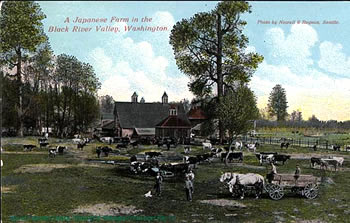 A Japanese farm in the Black River Valley south of Lake Washington. (Special Collections, University of Washington, Social Issues Files
Cc. Photo by Nowell and Rognon, Seattle.)
A Japanese farm in the Black River Valley south of Lake Washington. (Special Collections, University of Washington, Social Issues Files
Cc. Photo by Nowell and Rognon, Seattle.)
At roughly the same time, the states of Washington (1921) and Oregon (1923) passed laws, modeled on California's 1914 legislation, that prevented aliens ineligible to become citizens (they were really targeting successful Japanese growers) from owning farmland. The Issei generally found ways to circumvent the intent of these laws; one method was by putting property in their children's names. They could do this because, paradoxically, the American-born children of Asian immigrants were considered citizens, under the remarkable terms of the Fourteenth Amendment (1868) to the U.S. Constitution, which states that "All persons born...in the United States...are citizens of the United States and of the State wherein they reside. No State shall make or enforce any law which shall abridge the privileges or immunities of citizens of the United States...." This provision, of course, was tested by groups in the United States that hoped to deprive the children of Asian immigrants of the full benefits of citizenship, but the Supreme Court, in U.S. vs. Wong Kim Ark (1898), upheld the rights of the second generation. At birth the second generation automatically received those citizenship rights that the first generation would never be able to obtain; the former became citizens based upon where they were born, regardless of race, while the latter could never become citizens because of their race. (The differentiation between the land-owning rights of first- and second-generation immigrants from Japan plays a small role in David Guterson's fine historical novel Snow Falling on Cedars [1995], set around Puget Sound in the early 1940s and early 1950s.)
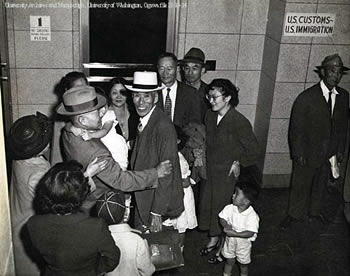
On the eve of World War Two, then, Asian- and Pacific-Island-origin peoples faced the severest restrictions of any immigrants to America. By law they could not migrate to the United States. Moreover, they could not become naturalized citizens, and were permanently unequal to other residents. The wartime treatment of people of Japanese descent in the United States, documented in the readings by Monica Sone and Roger Daniels, hardly offered a great deal of promise for improved race relations after 1940. Yet, for a variety of reasons World War Two did mark a dramatic turning point in U.S. immigration and naturalization policy. The conflict, writes Ueda (p. 42), "marked the end of American isolationism and the beginning of a new international leadership role for the nation. Henceforth, lawmakers saw immigration and naturalization policy as a tool for shaping foreign relations to further American self-interest." They also grew more sensitive to international criticism of racist policies, particularly during the Cold War. Over time peoples from Asia—facing the greatest restrictions—would be the ones who benefited most from the resulting changes. Wartime partnerships prompted the initial alterations. "To cement the alliance between China and the United States..., Congress in 1943 repealed the Chinese Exclusion Act of 1882," provided a small annual quota for Chinese immigrants, and enabled them to become naturalized citizens. "Furthermore, in 1946, Congress established naturalization rights for Filipinos and admitted aliens from India who had been excluded since the act of 1917 created the Asiatic Barred Zone."
This photograph of a family of Japanese migrants (above) was captured at the U.S. Customs and Immigration center by photographer Elmer Ogawa shortly after World War II. Between 1945 and 1967, Ogawa was the northwest correspondent and photographer for the Los Angeles-based Pacific Citizen, the newspaper for the Japanese-American Citizen's League. (Special Collections, University of Washington, Elmer Ogawa Papers and Photographs, 1923-1971. Box 13 [10 of 14].)
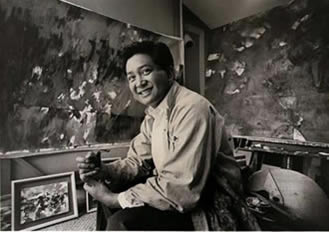
Reforms continued in 1952 with the McCarran-Walter Act. This legislation reaffirmed many exclusionary aspects of American immigration policy, but for Asians and Pacific Islanders it advanced some critical reforms. By putting forth the principle that admission of immigrants should not be based on race, it started dismantling the barriers that had been erected against Asian newcomers. Japan received an annual quota of 185 immigrants, and China a quota of 105. Moreover, the act abolished racial qualifications for citizenship. Immigrants from Asia could now be naturalized; they need not remain a permanent underclass, with fewer civil rights and civic responsibilities than their children.
Left: A Filipino artist in his studio. (Special Collections, University of Washington, Victorio A. Velasco Collection, Acc.#1435, 1948. Box 15 of 18.) Velasco was editor of the Filipino Forum, a newspaper for the increasing number of Filipinos residing in the Seattle area following World War II. U.S. acceptance of Asians began with the end of WWII.
Below: These Nisei WACs posed for their graduation from the language school at Fort Snelling, Minnesota, prior to their departure to occupied Japan in late 1945. (Daniels, Asian America, 174. Courtesy of U.S. Army)
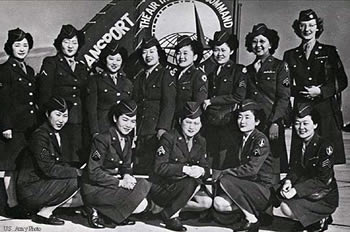
Reform of U.S. immigration policy crested in 1965, concurrent with the blossoming of the civil rights movement, when Congress passed the Hart-Celler Act. This law abolished the old, discriminatory, national-origins quotas, and established in their place a more egalitarian system. Each country in the eastern hemisphere received a quota of 20,000 visas, up to a maximum of 170,000 for the hemisphere. The western hemisphere got the same system in 1976; then in 1978 the hemispheric maximums were abandoned, and a worldwide ceiling of 290,000 annual immigrants was established. Additional reforms followed, in particular the Immigration Reform and Control Act of 1986 and another liberalization of 1990 which expanded the worldwide cap on annual immigrants to the U.S. to 700,000 for 1992. On top of these more general laws, Asian immigrants benefited from legislation addressing special situations. The Second World War and Cold War engaged Americans in wars around the Pacific Rim. During and after these wars, for a host of reasons, the U.S. made provisions to admit immigrants who came as the spouses of U.S. military and civilian personnel (War Brides Act of 1945) and who had been displaced by wars or who suffered persecution or the threat of persecution by mutual enemies (Displaced Persons Act of 1948, Refugee Relief Act of 1953, Indochinese Migration and Refugee Assistance Act of 1975, and Refugee Act of 1980).
|
American legislative reforms exerted a dramatic impact on Asian immigrants. Their numbers jumped immensely after 1965. During the 1970s, Asia provided more newcomers than any other continent—about 1.5 million to Europe's 840,000. And the fastest growing Asian immigrant groups were not those from Japan, China, or the Philippines, all of which had fairly well-established communities in the United States. South Koreans, South Vietnamese, Cambodians, Laotians, Thais, Indonesians, and many more national groups came to the United States in much larger numbers than before. In the three states of the Pacific Northwest, the numbers of people of Filipino descent surpassed those of Japanese or Chinese descent, and the numbers from other parts of East Asia also climbed quickly. In 1990, the U.S. Census counted the following Asian and Pacific-Island groups in the region. |
||||||||||||||||||||||||||||||||||||||||
As people in and around Seattle grew more concerned about rapid population growth in the years after 1985, they gradually realized the large role played by Asian immigrants in that growth. In King County between 1990 and 1996, "natural increase" accounted for 63% of the population growth, migration from other states for 5%, and immigration for 31%. Most of immigrants came from around the Pacific Rim. Between 1985 and 1995, more than two-thirds of all immigrants to King, Snohomish, and Pierce County arrived from Asia and the Pacific Islands; Europe accounted for only 19.5%. Despite the increased complexity of the Asian-origin population of the Northwest, little history has yet been written concerning groups other than those of Chinese, Japanese, and Filipino descent. Articles from big-city newspapers offer valuable information, and Seattle's Wing Luke Asian Museum is another important resource.
Immigrants who arrived from Asia during the 1970s, 1980s, and 1990s differed in several key ways from those who had come to the United States during the late 19th and early 20th centuries. First, the earlier arrivals had been predominantly laborers, but the more recent immigrants had a wider range of skills and training. In the late 1980s, Ueda tells us (p. 65), "immigrants from India, the Philippines, China, and Korea ranked in the ten nationalities with the largest representation of professional and managerial workers." (Many of those Asians who arrived as refugees from war were less well-educated and had a more difficult time entering the U.S. economy.) Second, the recent arrivals came more regularly as families, and they much more frequently intended to settle permanently in the United States. The age of the Asian "sojourner" had mainly passed, Ueda explains (p. 67): "Asian immigrants were quick to take out citizenship papers and composed a disproportionate share of the newly naturalized in the 1970s and 1980s. They began a spiral of chain migration: the numerous spouses, children, and parents who entered in the unlimited class of 'immediate relative' in turn sponsored their 'immediate relatives,' and so on. Consequently, annual admissions from each Asian country greatly exceeded the visa allotment of 20,000. These factors caused total immigration from Asia to skyrocket."
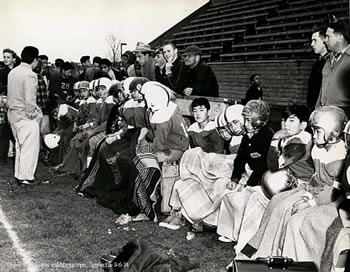
Left: School Diversity: The ethnic diversity and family orientation of post-World War II migration is seen in Elmer Ogawa's photograph of this football team, above. (Special Collections, University of Washington, Elmer Ogawa Papers and Photographs, 1923-1971. Box 9 [6 of 14].)
Another factor that affected the experiences of the recent Asian immigrants was the change in attitude among the "host" population. Recently arrived Asians met with less resistance and hostility from white Americans than before. They were hardly uniformly welcomed; vestiges of racism surely remained. But public animosity toward people of Asian descent had subsided considerably in the Pacific Northwest. Evidence for the changed attitudes comes from election returns around the state of Washington. The city of Seattle elected to the city council in 1960 Wing Luke, the first person of Chinese ancestry to win political office on the West Coast. King County elected Ruby Chow to the county council in 1974, the first Chinese American to sit on that body. And in 1996 the state of Washington elected as governor Gary Locke, the first Asian American outside of Hawaii to hold such office. More broadly, evidence for the changed attitudes can be found in the willingness of the people of the United States to admit the severity of the errors of internment of people of Japanese descent during World War Two, and establish a program of redress in 1988. More broadly still, evidence of the changed attitudes can be found in the idea that Asian Americans constituted "model minorities." [Roger Daniels surveys both the campaign for redress and the "model minority" idea in Asian America: Chinese and Japanese in the United States since 1850 (Seattle: University of Washington Press, 1988), ch. 8.]
The idea of a "model minority" was troublesome from a number of angles. For one thing, it encouraged the idea that discrimination against people of Asian descent had been completely replaced by admiration for them, and such was not the case. Some groups of Asian Americans had by 1970 attained on average more years of schooling than whites, for example, but that achievement did not translate into better or equal positions or pay in the working world. Nonetheless, the idea of a "model minority" did suggest a more favorable view of Asian Americans than had existed before World War Two. And what was particularly striking was that this idea was first coined in reference to Japanese Americans. Attitudes toward a group that was so vilified and mistreated during the Second World War had changed substantially.
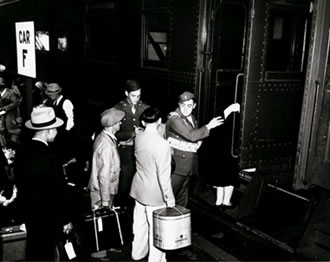
Internment (right). Japanese individuals boarding a train at the Union Station in Tacoma on their way to Camp Harmony located on the grounds of the Western Washington Fair in Puyallup. (Special Collections, University of Washington, Social Issues Files Cc/ii. Photo by Howard Clifford.)
The harsh experiences of Issei and Nisei in the Pacific Northwest (and especially Seattle) before and during World War Two are the subject of the readings by Monica Sone and Roger Daniels that accompany this unit. (For another account focusing on Seattle Issei, turn to Louis Fiset, Imprisoned Apart: The World War II Correspondence of an Issei Couple [Seattle: University of Washington Press, 1997].) The Daniels article traces the steps by which the U.S. government dealt with the "threat" presented by the Japanese and Japanese Americans, and samples the public opinion of whites before and during internment. (See Also: University of Washington Library virtual exhibit on Camp Harmony.) In this period, the protections that citizenship afforded the American-born children of Japanese immigrants were temporarily but profoundly overridden in a climate of fear, racism, and anger.
A similar process affected people of Japanese descent in Canada, where 21,000 Issei and Nisei were removed from coastal British Columbia to the interior. In contrast to the United States, however, where (as Daniels points out) the Supreme Court undermined the decision to intern loyal citizens in late 1944, the coerced displacement of Japanese Canadians—who did not have citizenship status and for the most part could not enlist in the Canadian army—persisted until 1949. (Only in that year did Canada grant all Japanese Canadians the right to vote and finally extend full citizenship rights to them). The lengthy forced relocation had lasting effects. In the United States, about two-thirds of the internees of Japanese descent returned to the west coast; in Canada, only about one-third did. By the time they were allowed to go back in 1949, seven years after being relocated, many had made new lives away from the coast. (For comparative discussion of people of Japanese descent in Canada and the U.S., see Roger Daniels, "The Japanese Experience in North America: An Essay in Comparative Racism," Canadian Ethnic Studies 9 [1977]: 91-100, and Daniels, "Chinese and Japanese in North America: The Canadian and American Experiences Compared," Canadian Review of American Studies 17 [1986]: 173-86.)
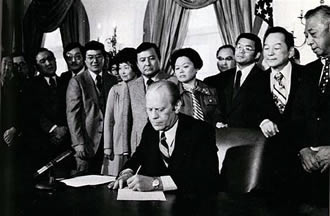 On February 19, 1976, President Gerald Ford signed Proclamation #4417 (left), which repealed Executive Order #9066 authorizing the internment of the Japanese during World War II. (In Daniels, Asian America. Seattle, 1988, p. 174. Photo from the Gerald R. Ford presidential library.)
On February 19, 1976, President Gerald Ford signed Proclamation #4417 (left), which repealed Executive Order #9066 authorizing the internment of the Japanese during World War II. (In Daniels, Asian America. Seattle, 1988, p. 174. Photo from the Gerald R. Ford presidential library.)
In 1988, the same year that the U.S. Congress approved a program of redress for those interned during World War Two, the Canadian government established its own redress program, offering an official apology and monetary compensation to those it had relocated in 1942. Both countries, then, were trying to make amends for the racist policies and practices toward Asian immigrants and their children that had characterized long stretches of their history. State and local bodies in Washington adopted similar paths of redress. The legislature and governor in 1983 passed a redress bill for the 38 Nisei state employees who had lost their jobs in 1942; the Seattle City Council in 1984 provided redress for five city employees who had lost their jobs; and in 1986 the Seattle School District adopted redress legislation for the 27 public school employees who had been terminated in 1942. [See Louis Fiset, "Redress for Nisei Public Employees in Washington State after World War II," Pacific Northwest Quarterly 88:1 (Winter 1996/97): 21-32.]
| Course Home | Previous Lesson | Next Lesson |